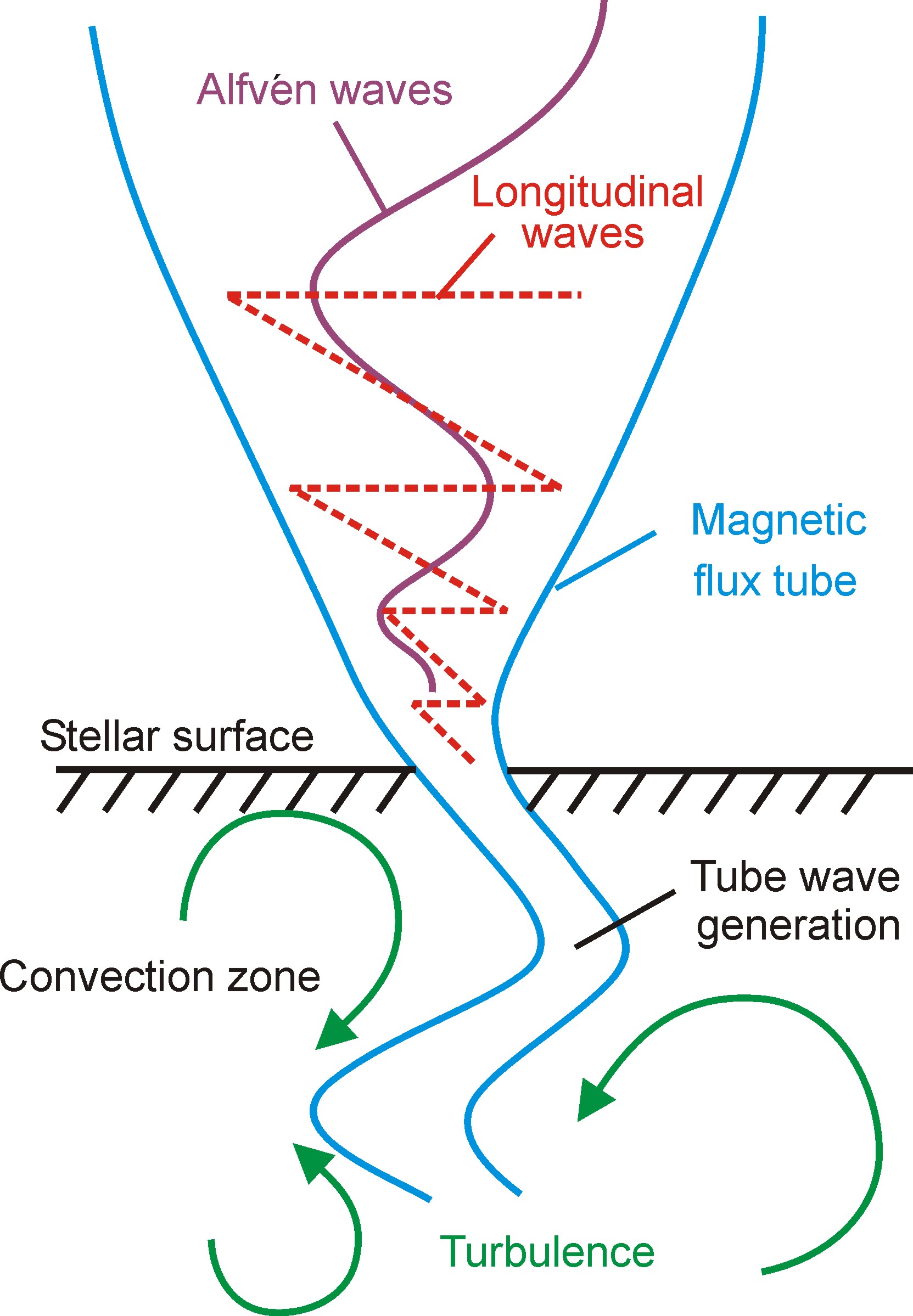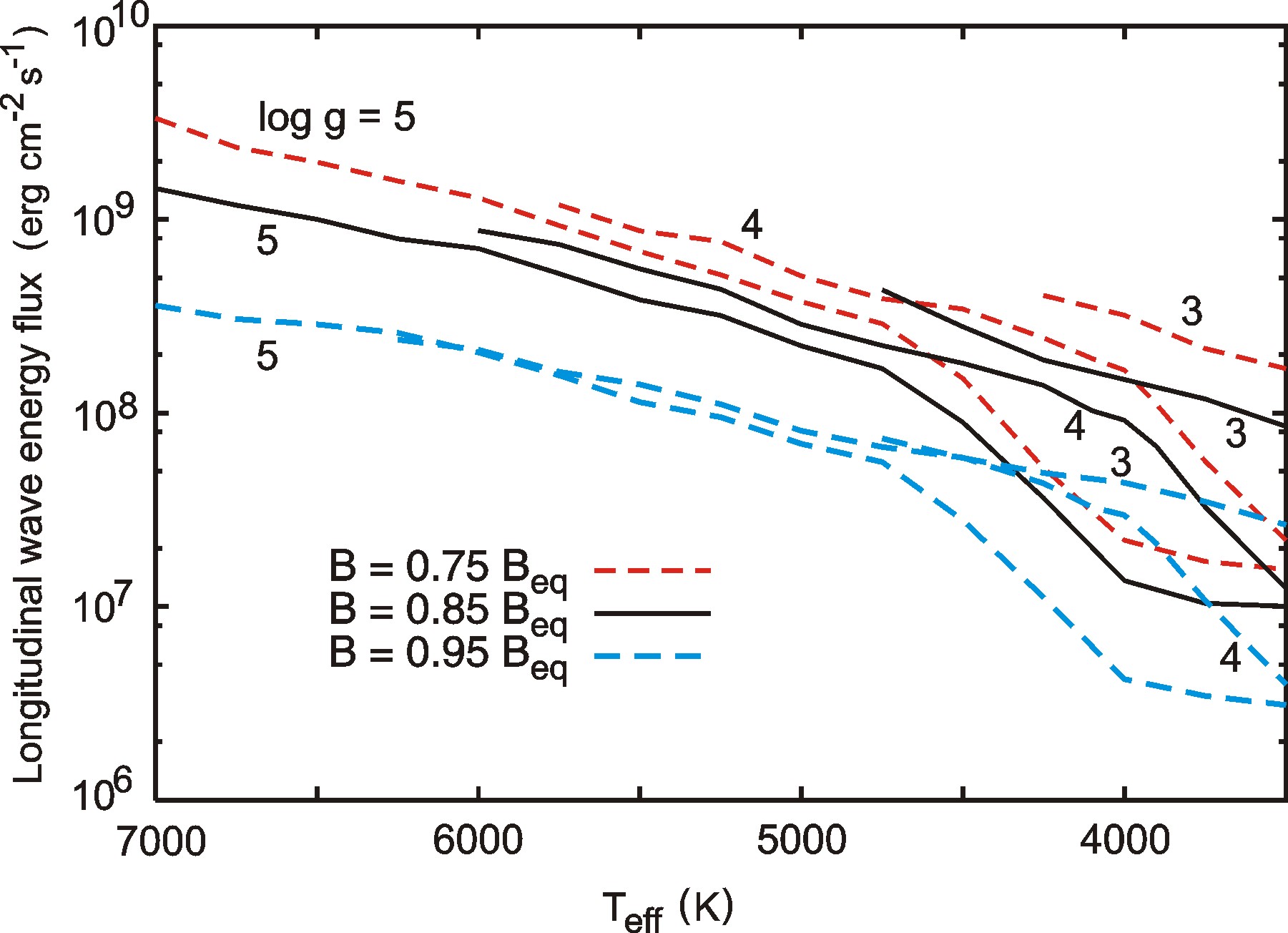
As our approach for nonmagnetic chromospheres led to encouraging results, is it possible to extend it to magnetic cases? Empirically it is known that the more rapidly a star rotates, the more densely it is covered by magnetic fields (Rutten 1986, Schrijver et al. 1989, Cuntz, Ulmschneider & Musielak 1998). At the present time there are intense efforts to develop a dynamo theory to enable to predict the magnetic field coverage of stars with different rotation periods P_{Rot}, but such a tool is not yet available. Other than to employ empirical relations, a way to proceed is therefore to simply assume a filling factor f for the magnetic field (f is the ratio of the area covered by magnetic flux to the total surface area of the star) and then look what consequences the assumed variation of f has for the chromospheric emission. We hope that in the near future a dynamo theory will be available which, after specifying the 4 parameters Z_M, T_{eff}, g and P_{Rot}, will give us a unique value of the filling factor f for the star.
To proceed with an assumed f, a number of additional assumptions has to be made. While the most noticeable magnetic feature on the Sun are sunspots, most of the magnetic flux arises in small magnetic elements called magnetic flux tubes. Recent very high resolution images of the solar granulation (Fig. 4) show that these magnetic elements are distributed everywhere over the solar surface, they are noticeably concentrated near the boundaries of supergranulation cells and are located in the dark intergranular lanes between granules where the cool gas of the upwelling granular bubbles flows back down into the solar interior. These magnetic elements are signatures for magnetic flux tubes, bundles of magnetic field in an otherwise field-free surroundings that emerge vertically from the deeper layers. The vertical orientation of the flux tubes is due to buoyancy because as a consequence of horizontal pressure balance between magnetic and gas pressures one has much lower gas pressure inside the tube.

Fig. 4 Granulation on the solar surface. Granules are hot gas bubbles that rise up from the convection zone to the solar surface where they cool and after lifetimes of a few minutes vanish again. Small white specs called filigree are seen that are signatures of magnetic flux tubes. They are found in the dark intergranular lanes where the cooled gas converges and flows back down into the convection zone. Also seen are small sunspots (dark spots). The picture is from the Swedish Solar Tower at La Palma

Fig. 5 Magnetic flux tubes on stars with different magnetic filling factors. Left: star with a low filling factor, there are few tubes on the star. Right: star with a high filling factor. The magnetic fields (blue) spread until they fill out the entire available space
Another assumption that has to be made is about the value of the magnetic field strength B inside the flux tube. If there is essentially no gas inside the tube then the external gas pressure p_E is equal to the magnetic pressure in the tube p_E = B_{EQ}^2/8pi, where B_{EQ} is the equilibrium field strength. But realistic tubes are not empty and therefore one must have B < B_{EQ}. MHD-simulations of the convective collapse of gas in a magnetic flux tube reveal the true value of the field strength B and the amount of gas pressure left in a given tube. However, as such calculations are not yet available for arbitrarily specified stellar parameters we assume that one has typical solar conditions where the tubes have a range of field strengths B/B_{EQ} = 0.75, 0.85, 0.95 (Ulmschneider, Musielak & Fawzy 2001).
We therefore picture the star as covered by a large amount of magnetic flux tubes, consistent with an assumed value of f (Fig. 5), which at the stellar surface have diameters of roughly a scale height H and a field strength given by B/B_{EQ}approx 0.85. These tubes subsequently spread with height according to horizontal pressure balance and at a certain height completely fill out the available space. The flux tubes go down into the convection zone and it is imagined that they are perturbed by the gas motions that take place in the nonmagnetic regions outside the tubes. By these perturbations three types of MHD-waves are generated. Squeezing the tube generates longitudinal waves, shaking the tube produces transverse waves and twisting the tube gives rise to Alfv'en waves (Fig. 6).

Fig. 6 Magnetohydrodynamic wave generation in magnetic flux tubes when turbulent convection bends and compresses the tubes

Fig. 7 Longitudinal tube wave fluxes for stars versus T_{eff} for given log g, with solar metallicity Z_m=[0], alpha =2 and different ratios of magnetic field strength B_0/B_{eq}, after Ulmschneider, Musielak & Fawzy (2001)
By letting time-dependent pressure oscillations or horizontal velocity fluctuations driven by Kolmogorov turbulence act on magnetic flux tubes, the longitudinal or transverse Alfv'en wave energy generation can be computed. Figure 7 shows the longitudinal wave energy flux for stars of different T_{eff} and g (Ulmschneider & Musielak 1998, Ulmschneider, Musielak & Fawzy 2001), assuming solar metallicities and various ratios of B/B_{eq}. For similar calculations for transverse Alfv'en waves see Huang, Musielak & Ulmschneider (1995), Musielak & Ulmschneider (2001, 2002a, b).


